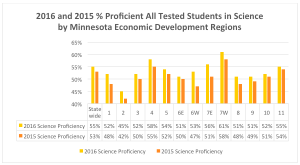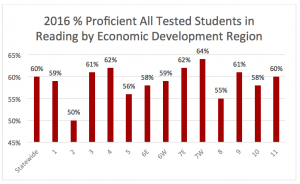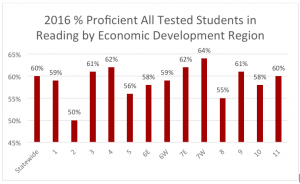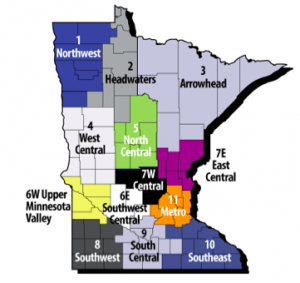A regional analysis of the 2016 MCA test results in math, reading and science, released today by MREA, shows an increase in science proficiency across Minnesota’s rural schools.
Rural science achievement improved with 2.4 percent more Greater Minnesota students in grades 5, 8 and demonstrating proficiency. This improvement was twice the metro improvement of 1.2 percent and exceeded the statewide improvement of 1.7 percent.
 Leading the rural regions were the Upper Minnesota Valley (6E) and East Central (7E) with increases of 5.7 percent and 5.0 percent respectively.
Leading the rural regions were the Upper Minnesota Valley (6E) and East Central (7E) with increases of 5.7 percent and 5.0 percent respectively.
Rural science achievement continues to lag the statewide average but the gap has been significantly reduced from
2.9 percent to 1.8 percent.
This is an example of closing the gap and raising the bar between rural and metro science achievement. By staying focused on science curriculum alignment and instruction, rural schools and teachers can continue to close this gap and outpace statewide growth.
Reading and Math Achievement
Overall, reading and math achievement regional achievement mirrors the statewide pattern with very slow growth. Two regions that outpaced the state and all other regions in student growth were East Central (7E) with a 4 percent growth in reading proficiency and the Arrowhead (3) with a 3 percent growth in mathematics.
In both reading and math, five Greater Minnesota regions exceeded or equaled the state average achievement in and seven lag the state average.


Once again the Central Region (7W) — the counties of Benton, Sherburne, Stearns, and Wright —led the state in reading (64%), math (66%), and science (61%) proficiency. The region is 88 percent white and 3 of the 4 counties have less than 12 percent of their children in poverty. The districts in this region are adding value to lead the state in student achievement in all three subjects, but face fewer of the conditions underlying achievement gaps in Minnesota.
Improving Results
MREA’s regional analysis of MCA results provides a benchmarking unit of analysis for teacher and district leaders to improve their curriculum, instruction and student learning, and to identify regional trends requiring collaborative efforts for improvement. Benchmarking and tracking achievement gains in one’s district as compared to selected districts is a proven strategy to generate achievement gains in a school district.
Minnesota’s Economic Development Regions

For more information on the 2016 MCA Test results:
- MDE provides a good powerpoint of 2016 MCA statewide results with racial and economic gaps in achievement.
- Find results for your school and district at Minnesota Report Card.
- The data for this regional analysis and for more detailed benchmarking information is found in the Assessment and Growth files at MDE Data Analytics.
*The MDE Fact Sheet states the math MCA proficiency rate is 61 percent. The ‘partially meets’ category has an index which factors into the proficiency standards but is beyond MREA to calculate accurately. To accurately benchmark a district in math, use only the meets and exceeds proficiency count in your district. There is no difference in proficiency rates for reading or science.

